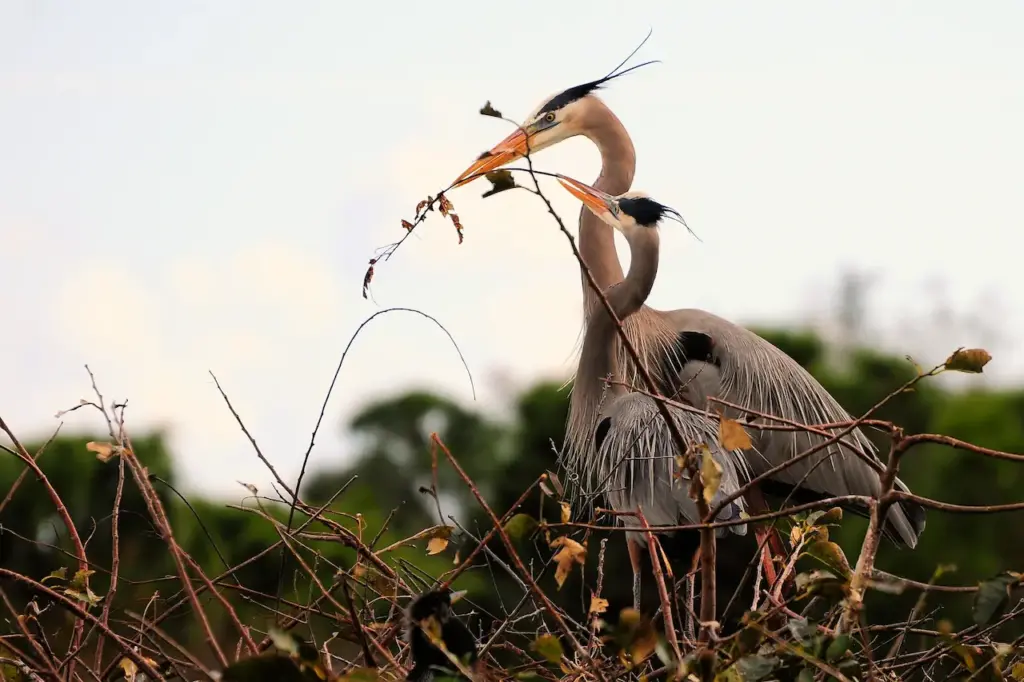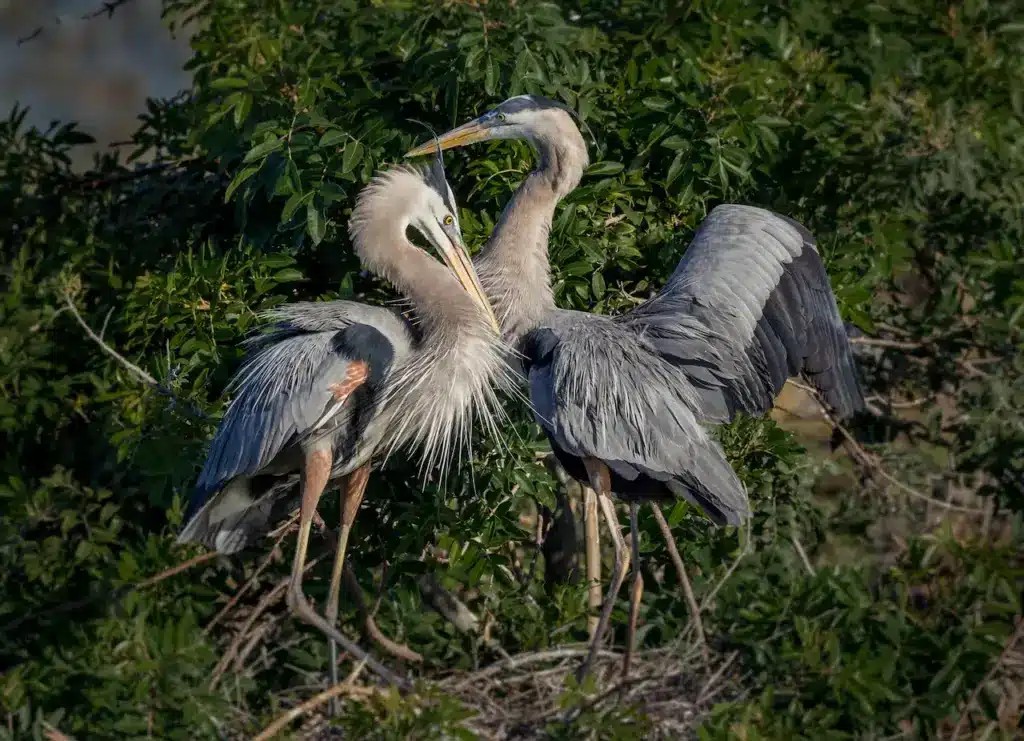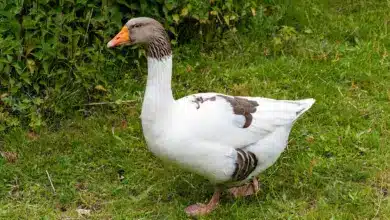Great Blue Herons
The Great Blue Herons (Ardea herodias) are the most common and best-known of all wading birds. They occur naturally in North and Central America, the West Indies, and the Galápagos.
In North America, they are the largest of all naturally occurring herons. Globally, this heron’s size is surpassed only by the Goliath Heron and the White-bellied Heron. The Great Blue Heron is sometimes referred to as a “crane” – erroneously so since they are not related to the crane family.

Great Blues are also called Blue Cranes, California or Florida Herons, Espiritu Santo Herons, San Lucas Herons, and Treganza’s Herons.
Great Blue Herons are related to and resemble the slightly smaller European Grey Heron and the similar-sized South American Cocoi Herons or White-necked Herons.
Since their ranges don’t overlap – except for some occasional vagrants – confusion is unlikely for the most part.
The Great Blue Heron can be identified by their chestnut-brown flanks and thighs, and the Cocoi Heron has more extensive black markings on the head than the other two.
They are typically found near the shores of open water and in wetlands over most of North and Central America as well as the Caribbean and the Galápagos Islands and are rare vagrants to Europe.
Heron Information … Heron Species (Listing) … Heron Species Photos
These majestic birds often stand motionless as they scan their environment for prey, or slowly wade in water with long, deliberate steps. Once they spot their prey, they will strike like lightning to grab a fish or frog. In flight, they are easily recognized by their tucked-in necks and long legs trailing out behind.
Great blue herons are mainly active in the mornings and at dusk when fishing is best. They are solitary predators, preferring to hunt alone. They also travel alone, except during migration when one might see up to 10 together.
However, they often breed in groups called colonies, and during the day they will sleep with flocks of over 100 other herons. Great Blue Herons are also extremely territorial and will aggressively defend their nests.

Subspecies, Ranges, and ID:
The subspecies mostly look alike; except for slight differences in size and plumage tone. The exceptions are the white morph (also known as the Great White Heron) only found in south Florida and some areas in the Caribbean; and an intermediate morph (or hybrid ?) found in southern coastal Florida.
- Great Blue Heron, North-eastern Great Blue Heron (Ardea herodias herodias – Linnaeus, 1758) – Nominate Race – Occurs in most of northern and central America (except as below).
- Northwest Coast Heron, Northwestern Coast Heron (Ardea herodias fannini – Chapman, 1901) – The Pacific Northwest from southeastern Alaska south to coastal Washington.
- Ward’s Heron (Ardea herodias wardi or Ardea wardi wardi – Ridgway, 1882) – Kansas and Oklahoma to northern Florida. Some sightings in southeastern Georgia.
- Galapagos Great Blue Heron (Ardea herodias cognata – Bangs, 1903) – Galapagos Islands
- Great Blue Heron (Ardea herodias occidentalis – Audubon, 1835) – mostly white morphs – commonly referred to as the Great White Herons (Ardea occidentalis occidentalis) – Southern Florida through West Indies (Caribbean islands) to islands off Venezuela. =
- The debate about the taxonomy of this race is ongoing. The Great White Heron was originally described as a distinct species. However, according to the Texas Bird Records Committee Report (2006), the “Great White” population of the Great Blue Heron is “simply a color morph” (TBRC 2006, Butler 1992) – mainly based on the observations that Great White and Blue Herons interbreed. Now its status is under review again. The fact that Great White Herons differ from the Great Blue Herons in the obvious lack of pigments resulting in an all-white plumage, some differences in the body length and length of the head plumes exist; and have a differently shaped bill and different lengths of the head plumes gives support to the theory (once again) that the Great White Herons are indeed a separate race (Ref. David Sibley.) Mayr and Meyerriecks both argue that the “Great White” Heron is not a separate species, but believe that it is a valid subspecies based on the fact that mixed pairs exist, that there are no clear differences in behavior, and only subtle physical differences. They both found that Great Whites are significantly larger than Great Blues from the Florida peninsula, which, in turn, are significantly larger than Great Blues from farther north.
- [Würdemann’s Heron Ardea occidentalis wurdemanni – considered invalid race] – By most considered an intermediate morph or a hybrid between A. h. occidentalis (white morph) and A. h. wardi (normal [blue] morph) – ID: Has the same bluish-grey plumage of the “normal” Great Blue Heron, except it has a mostly white head and neck. Occurs in the same range as the all-white subspecies, the Great White Heron, along the coastal areas of Southern Florida
Distribution / Range
The Great Blue’s range stretches from southern Alaska and southern New England, British Columbia through southern Canada to the United States and Mexico, the Caribbean (the West Indies), and the Galapagos Islands situated in the Pacific Ocean west of continental Ecuador in northern Southern America.
They occur in any habitat that offers easy access to water. They are not found in deserts and high mountain areas.
Those populations found east of the Rockies (in the northern part of their range) are migratory and travel south to winter in Central America or northern South America. Those found in the southern United States southwards and on the Pacific coast are resident (non-migratory).
They occur in both saltwater and freshwater habitats; in marshes, rivers, lakes, bays, lagoons, open coasts/shores, and ponds. They may also raid backyard goldfish ponds or forage in grasslands or agricultural fields.
They are native to:
Anguilla, Antigua and Barbuda, Aruba, Bahamas, Barbados, Belize, Bermuda, British Virgin Islands, Canada, Cayman Islands, Colombia, Costa Rica, Cuba, Dominica, Dominican Republic, Ecuador, El Salvador, Grenada, Guadeloupe, Guatemala, Haiti, Honduras, Jamaica, Martinique, Mexico, Montserrat, Netherlands Antilles, Nicaragua, Panama, Puerto Rico, Saint Kitts and Nevis, Saint Lucia, Saint Martin, Saint Pierre and Miquelon, Saint Vincent and the Grenadines, Trinidad and Tobago, Turks and Caicos Islands, United States, United States Minor Outlying Islands, US Virgin Islands, Venezuela, Virgin Islands.
They are vagrants (occasional visitors) to the following countries:
Azures, Brazil, Cape Verde, England, France, Greenland, Hawaii, Netherlands, Portugal and Spain
Description
This Great Blue Heron is the largest North American heron:
- It stands about 4 feet (122 cm) tall.
- It has a body length of ~ 38.19 – 53.94 inches (97 – 137 cm).
- It weighs, on average, 5.5 lbs (2.5 kg).
- Its wingspan is about 7 feet (213 cm).
- Its stride is around 9 inches (22 cm).
Males are generally larger and have a puffy plume of feathers behind their heads; otherwise, males and females look alike.
The wings are long and rounded. The tail is short and the neck is long. The long, bill tapers to a point at the end; it is yellowish, turning orange briefly at the start of the breeding season. The toes and legs are greyish, turning orange as the breeding season commences.
In flight, they can easily be identified by their slow, yet strong, wing beats, tucked-in neck, and trailing long legs. In flight or when resting, the Great Blue Heron usually tucks its head into an S-shape.
The adult plumage is mostly dull blue-grey except …
- The face is white with a long black stripe extending from behind the eye to the back of the head ending in black plumes (in breeding adults)
- There are white feathers on the top of the head.
- The neck is streaked with white, black and rust-brown.
- The shoulders are black.
- There are chestnut-colored feathers on the thighs.
- The plumage below (underparts) is whitish.
There is also an all-white version of the great blue heron, the great white heron. Some considered a white morph, while others a separate species. The Great White occurs in coastal southern Florida. It has an all-white plumage, yellow legs, and a yellow bill.
Juveniles have a duller plumage; a dull blackish-grey crown, and a weakly defined flank pattern. The bill is dull grey-yellow.
Similar Species
- Sandhill Crane: This is heavier, shorter bill, and has a red cap. In flight, its neck and legs are outstretched.
- The Great Egret is smaller in size and has black legs.
- The Reddish Egret and Little Blue Heron are much smaller and lack the white on the head and yellow bill.
- The Cocoi Heron has a striking white neck and solid black crown.
- The European Grey Heron has an all-grey neck.
- The Great Egret can easily be confused with the Great White Heron, but the Great Egret can be identified by its black legs and smaller size.
Breeding / Nesting
In the northern parts of their range, most breeding activities occur from March to May; in the southern parts of their range from November to April.
They are monogamous, remaining with one mate per breeding season. They typically produce only one brood a year; however, may raise another brood, if the first clutch gets destroyed or abandoned.
Great Blues typically breed in colonies – sometimes alongside other species of herons. There may be between 5 – 500 nests per colony; the average being 160 nests. Such breeding colonies are known as “heronries” or “rookeries.” They typically seek out habitats that include tall trees for nesting.

These bulky yet shallow platform nests are constructed out of sticks and twigs, and lined with soft material (plant material, feathers, down, etc.). These nests are typically placed high off the ground into the branches of trees or shrubs, and to a lesser extent in the reeds or on the edges of cliffs. The nesting sites are close to bodies of water or wetlands, swamps, tidal flats, shallow coastal bays, or shores of ponds, lakes, and rivers. Great Blues usually nest in the same spot from year-to-year, and may even use the same nest.
The female lays 2 – 7 (mostly 4) pale blue eggs, which are incubated for about 25 – 30 days to hatching. The young hatch over several days; and both parents feed them with regurgitating food. The first chick to hatch is generally the largest and strongest chick and will receive the most food and will, therefore, grow faster and have a better chance of survival than its smaller siblings.
The young fledge (leave the nest) when they are 60 – 90 days old and reach reproductive age when they are 22 – 24 months old.
Diet / Feeding
When and where they feed …
Great Blue Herons feed throughout the day, but most of their foraging occurs around dawn and dusk.
They generally feed in shallow water or at the water’s edge, but will also field in fields or drop from the air or a perch into the water to catch prey.
What they eat …
The Great Blue Heron primarily feeds on small fish; but will also take shrimp, crabs, frogs, insects (including dragonflies and grasshoppers), reptiles (including salamanders, snakes, and turtles), rodents, and small birds. They will also raid backyard goldfish ponds.
Research by Rob W. Butler (Professor, Bird Studies Canada Pacific Wildlife Research Center) indicated that those Great Blue Herons occurring in colder climates primarily fed on sticklebacks, shiners, sea perch, pipefish, sculpins, etc., as they require approximately 30% more energy above basal metabolic costs to fuel their activities.
How they hunt and eat …
Great Blue Herons may establish feeding territories in winter, which they aggressively defend.
While foraging, they either wade slowly or stand still, stalking fish, frogs, and other prey in shallow water or open fields. They may also drop from the air or a perch into water.
Once they spot their prey, they grab or stab their prey with their long, sharp bill and a lightning-fast thrust of the neck and head.
They usually swallow their prey whole and have been known to choke on prey that is too large. Outside the breeding season, they generally hunt and feed alone.
Calls / Vocalizations
Great Blue Herons are generally quiet. When startled, alarmed, or during territorial disputes, the Great Blue Herons will emit harsh croaking sounds: kraak. When disturbed near their nests, their calls sound like frank.
When greeting members of their family, an ar can be heard. During courtship displays, they snap their bills together and use complicated body movements to attract a mate.
Lifespan
In the wild, Great Blue Herons have a maximum recorded lifespan of 24.5 years; however, most do not live that long.
The average lifespan for a great blue heron is around 15 years. As with most animals, they are most vulnerable when they are young.
More than half (69%) of the great blue herons born in one year will die before they are a year old.
Repeated human disturbance close to the nesting site can also result in the abandonment of eggs or chicks.
Accidents (including roadkill), detrimental/harsh weather conditions, illegal hunting, and predation of eggs, nestlings, and adults are typical causes of premature death.
Vultures, blackbirds, hawks, bears, and raccoons prey on eggs and nestlings; while adults can be taken by Bald Eagles, Golden Eagles, and, less frequently, Great Horned Owls and Red-tailed Hawks.
Alternate (Global) Names
Catalan: Bernat americà … Chinese: ??? … Czech: Volavka velká … Danish: Stor Blåhejre … Dutch: Amerikaanse Blauwe Reiger, Grote Blauwe Reiger … Finnish: Amerikanharmaahaikara … French: Grand Héron, Grand Héron bleu, Héron bleu, Héron de Wurdemann, Gwo Krabye ble … German: Kanadareiher, Nordamerika-Reiher … Icelandic: Bláhegri … Italian: Airone azzurro, Airone azzurro maggiore … Japanese: Ooaosagi … Lithuanian: Kanadinis garnys … Norwegian: Herodiashegre … Polish: Czapla modra … Portuguese: Garça-azul-grande, Garça-real-americana … Russian: ??????? ?????, ????? ??????? ??????? … Slovak: Volavka statná … Slovenian: Ameriška siva ?aplja … Spanish: Garcilote, Garza Azul, Garza Azulada, Garza Ceniza, Garza Morena, Garzón, Garzón Azul, Garzón azulado, Garzón Cenizo, Garzón moreno, Rabihorcado Grande … Swedish: Amerikansk gråhäger … Turkish: Amerika Gri Bal?kç?l?





